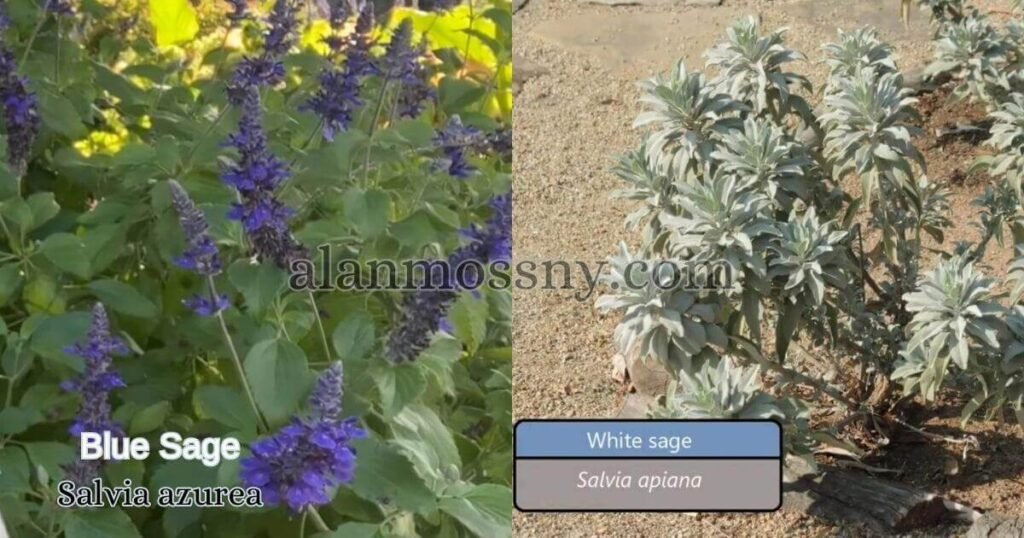Blue Sage vs. White Sage: The Best Smudging
Unveil the hidden treasures of Blue Sage vs White Sage. Smudging has long been an important element of many cultures and spiritual rituals worldwide. Burning sacred herbs, such as sage, has been used to cleanse and purify environments, objects, and individuals.

Today, we delve into the distinctions and similarities between two popular types of sage used for smudging: Blue Sage vs White Sage. As the renewed interest in smudging and its benefits continues to grow, we examine the unique properties of each, from their benefits and beauty to their scents and spiritual significance.
The Aesthetic Appeal: Blue Sage vs White Sage
| Blue Sage | White Sage |
| Blue Sage, scientifically known as Salvia azurea, has a striking appearance, with its vibrant blue flowers and elongated stems that can grow up to three feet tall. | White Sage (Salvia apiana) is native to the southwestern United States and Mexico. It is a perennial evergreen shrub with a maximum height of five feet. |
| Its beauty is not just limited to its color, as it also boasts attractive, silvery-green leaves. Native to the Great Plains of the United States, blue sage is often used in gardens and dried floral arrangements for ornamental purposes. | The plant is characterized by its greyish-white leaves and pale lavender flowers, adding subtle elegance to any space. |
| White sage is also a popular choice for a landscaping technique that focuses on drought-tolerant plants. |
Opinion: Both blue and white sage are beautiful in their own right, with the former being more vibrant and colorful, while the latter exudes subdued elegance.
The Scents: Blue Sage vs White Sage
| Blue Sage | White Sage |
| Blue Sage has a lighter and somewhat sweeter fragrance compared to white sage. | On the other hand, the perfume of white sage is powerful, aromatic, earthy, and just a little harsh. |
| Its aroma is reminiscent of fresh mountain air with hints of floral undertones. The scent of blue sage is often described as uplifting and soothing, making it a popular choice for relaxation and stress relief. | Native American cultures have used it for generations in cleansing and protection rituals because of its distinctively strong aroma. The smell of white sage is often associated with spiritual cleansing and the banishment of negative energies. |
Opinion: Blue sage is the ideal choice if you prefer a lighter, more delicate scent. White sage is the best option for individuals seeking a strong, earthy aroma.
The Benefits: Blue Sage vs White Sage
Both blue and white sage are believed to have numerous health and spiritual benefits stemming from their antimicrobial and anti-inflammatory properties. But there are certain distinctions between the two in terms of particular applications and advantages.
| Blue Sage | White Sage |
| Blue sage’s relaxing and calming properties on the body and mind are well documented. It is frequently employed to ease tension, lower anxiety, and encourage relaxation. | White Sage is renowned for its powerful cleansing and purifying abilities. It is often used to rid spaces of negative energies and to protect against unwanted influences. |
| Due to its anti-inflammatory properties, blue sage has been utilized to treat colds and irritated throats for centuries. | White sage has a long history of medicinal usage, including treating respiratory problems, allergies, headaches, and its spiritual applications. |
Opinion: If you’re looking for calming and soothing benefits, blue sage is the perfect choice. For powerful cleansing and purification, white sage is the preferred option.

The Spiritual Significance
Blue Sage and white sage both hold significant spiritual importance in various cultures and traditions. However, their symbolism and usage differ slightly.
| Blue Sage | White Sage |
| Blue Sage is often associated with the element of water, symbolizing healing, cleansing, and tranquility. | White Sage is actually connected with the element of air and is known for purifying both physical and spiritual spaces. |
| It’s soothing scent and calming properties make it a popular choice for meditation, emotional healing, and fostering positive energy. | Its powerful cleansing abilities have long been revered in Native American cultures, where it is used in smudging ceremonies to banish negative energies and promote overall well-being. |
| Blue sage is also linked to the throat chakra, which represents communication, self-expression, and speaking one’s truth. As such, it is often used to encourage open and honest communication in relationships and personal growth. | People also think that white sage makes them more spiritually aware and intuitive. It’s a popular option for people seeking to strengthen their spiritual practice and connection to the cosmos. |
Opinion: While both blue and white sage has their own unique spiritual significance, blue sage is more closely associated with emotional healing and communication, whereas white sage is known for its potent cleansing and purifying properties.
Conclusion
The debate between blue sage and white sage comes down to personal preference and the specific benefits you are seeking. Both types of sage offer their own unique beauty, scents, and spiritual significance, with blue sage being more geared toward relaxation, emotional healing, and open communication and white sage being renowned for its powerful cleansing and purification properties.
You can follow this category to know more about (1) black sage, (2) blue sage.
FAQs: Blue Sage vs White Sage
Can I use both blue sage and white sage together in my smudging rituals?
Yes, you can use both blue and white sage together in your smudging rituals. This combination can provide a balance of healing, purification, and harmony. However, be mindful of the different scents and properties of each type of sage, and consider how they might complement or contrast with each other.
Are there any precautions to consider when smudging with blue or white sage?
When smudging with either blue or white sage, ensure proper ventilation in the space to avoid respiratory irritation. Never leave burning sage unattended, and be sure to extinguish it completely when you’re finished. Additionally, be respectful of the cultural and spiritual significance of these plants, particularly white sage, which is sacred to many Native American tribes.
Can I grow blue sage and white sage at home?
Yes, both blue sage and white sage can be grown at home, provided you can recreate their native growing conditions. Blue sage thrives in well-draining soil and full sun, while white sage prefers arid, sandy soil with good drainage and plenty of sunlight. Be sure to research the specific requirements of each plant to ensure successful growth.
How do I properly smudge with blue or white sage?
To smudge with blue or white sage, begin by lighting the end of a sage bundle or loose leaves until they begin to smolder. Gently blow out the flame, allowing the sage to produce smoke. Use a feather or your hand to waft the smoke around the space, object, or person you wish to cleanse.
